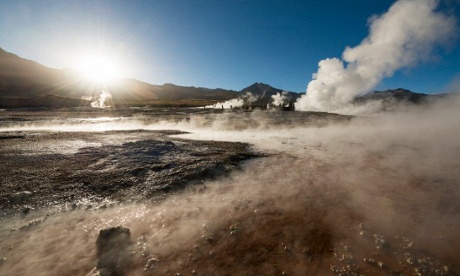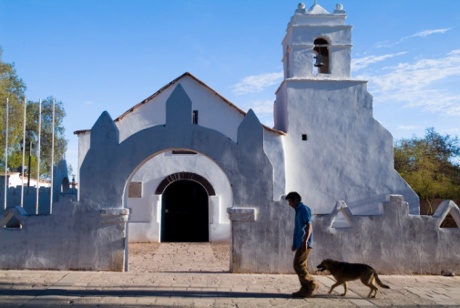 |
| Antennas form part of the Atacama Large Millimeter Array (Alma), in the Atacama desert // Photo by Alamy |
Rachel Dixon, The Guardian, February 5, 2015
Midnight in the desert. With a group of eight, I am huddled around a telescope 150 times stronger than the naked eye, staring at the night sky. From a dazzling mass of stars, we zoom in on individual pricks of light: a single star, a double, a nebula, a cluster, even a galaxy. Heading outside and looking up, constellations emerge from the crowded heavens, sketched out to us by a powerful laser.
Dark sky reserves have sprouted up everywhere from Northumberland to Namibia. But for the ultimate stargazing experience, the Atacama desert in northern Chile has the clearest night skies on Earth. It is high, dry (one of the driest places in the world) and unpolluted. Several top-level observatories have set up home here, and tourists are hot on their tail.
Related: Rock of ages: Chile’s Quezala canyon
“Astro-tourism is completely new,” says astronomer Bill Dent, who has worked in Chile for six years. “You didn’t get it 10 years ago.”
An increasing number of night-time tours cater for this new-found interest, including the one I’m on, run by Tierra Atacama and based in the oasis town of San Pedro de Atacama. But for real astronomy buffs, there is a new attraction that is even more exciting. The revolutionary Alma observatory, the world’s largest astronomical project, opens for tours next month. Alma captures star and planet formations billions of light years away, so you are viewing the dawn of the universe. Using an array of 66 antennae that together make up the equivalent of a 10-mile-long telescope, it can uncover details with at least 10 times more resolution than the Hubble space telescope.
The drive to Alma HQ, 20 miles north-east of San Pedro, winds past spiky cardon plants and wild donkeys. Soon, the land has a red tinge, pocked with craters and crevasses, and the Liscar volcano smokes on the horizon. It’s as if you’ve arrived on Mars.
The public tours will take place at the Operations Support Facility (OSF), at an altitude of 2,900 metres, where a visitors’ centre is being built. Guests will also visit the laboratory and control centre, and the hangar where the antennae are made and repaired. There are always a couple of antennae being worked on, faces upturned to the scorching sun like overgrown Wall-Es. There are plans for an on-site hotel and an Alma museum down in San Pedro.

The geysers at El Tatio. Photograph: Ben Pipe Photography/Corbis
As this is a radio telescope, not an optical one, there is no nighttime stargazing at Alma – you come here in dazzling daylight to be wowed by the scale, the site and the cutting-edge science. And don’t expect to get up close and personal with the telescope. Visitors won’t ascend to the Chajnantor plateau at 5,000 metres, where most of the antennae are sited – and for good reason. I’m allowed up, under strict medical supervision, only to be rushed straight back down, wired to an oxygen canister, when the altitude took its toll. (Oxygen saturation levels must be more than 80%; mine plummeted from 96% at 4,000 metres to 68% at 5,000.)
Still, there is plenty to see at the OSF, and the views over Chile’s Valley of the Moon are spectacular. Dent is convinced the tours will prove popular. “Astronomy is fun for more people than particle physicists,” he says. “Everyone can look up at the sky. It has an immediate appeal, especially for kids.”
Back in San Pedro, you can visit the wonderful little Meteorite Museum, housed in two geodesic domes, which conducts stargazing tours. All the meteorites on display were found in the Atacama desert and you can even touch some of the 4½-billion-year-old rocks. The town is a gateway to many of the desert’s natural attractions. I visit the El Tatio geysers, a sunrise spectacle of erupting water, steam and hot volcanic mud, and take a dip in the thermal pools. Then there are the salt flats, the lagoons, Death Valley, the flamingo reserves …

The adobe church of San Pedro de Atacama. Photograph: Richard Nowitz/Getty Images/National Geographic
San Pedro’s dusty streets may be thronged with tourists, but it is still an appealing, easygoing huaso (cowboy) town: one-storey adobe buildings, a leafy main square with an archetypal Andean church; an excellent archaeological museum.
Chela Cabur is the best bar (really the only bar, because at all the others you have to order food). It is decorated with football shirts and vintage film posters, and only serves beer; the micheladas (beer with lemon juice and salt) are medicinal on a hot day. Ayllu is a good spot for dinner, slightly off the main drag on Toconao Street. You can sit in the courtyard around a brazier and eat llama a la pobre – fatty, tender llama meat on the bone, served with chips, fried eggs and onions. For a twist on the Chilean (and Peruvian) national drink, try a rica rica cocktail – a pisco sour topped with a fragrant desert herb.
Related: The Brecon Beacons' Dark Sky Reserve: five ways to see it
There are scores of places to stay, from dirt-cheap hostels to seriously luxurious hotels. Hotel Altiplanico is on the deluxe end of the spectrum, but without the sky-high prices. It is designed like a traditional village: my room is an adobe hut with a straw roof, a sunny terrace and an outdoor shower. At night, the grounds are deliberately dimly lit. I don’t need to be armed with a telescope or up a mountain – I simply sit on my terrace and marvel at the peerless Chilean night sky.
• The trip was provided by Rainbow Tours (020-7666 1260, rainbowtours.co.uk). A tailormade eight-day trip costs from £1,995pp, including two nights’ B&B in Santiago and four in the Atacama desert, return flights from ondon, transfers, tours of El Tatio geyser and Alma. Alma tours are free and can be booked at almaobservatory.org
This article originally appeared on guardian.co.uk
This article was written by Rachel Dixon from The Guardian and was legally licensed through the NewsCred publisher network.
![]()